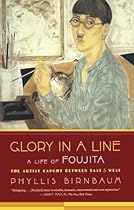Read Glory in a Line: A Life of Foujita--the Artist Caught Between East and West by Phyllis Birnbaum Online
[Phyllis Birnbaum] ☆ Glory in a Line: A Life of Foujita--the Artist Caught Between East and West ↠ Download Online eBook or Kindle ePUB. Glory in a Line: A Life of Foujita--the Artist Caught Between East and West Foujita was the only Japanese artist to be considered part of the "School of Paris," which also counted among its members such prominent artists as Picasso and Modigliani. After Japan's defeat, he was scorned for his devotion to the military cause and returned to France, where he remained until his death in 1968. Acclaimed writer and translator Phyllis Birnbaum not only explores Foujita's fascinating, tumultuous life but also assesses the appeal of his paintings, which, in their mixture of Easte

| Title | : | Glory in a Line: A Life of Foujita--the Artist Caught Between East and West |
| Author | : | |
| Rating | : | 4.57 (582 Votes) |
| Asin | : | 0865479755 |
| Format Type | : | paperback |
| Number of Pages | : | 352 Pages |
| Publish Date | : | 2017-11-03 |
| Language | : | English |
He was equally well known for his wild behavior and flamboyant dress. (Nov.)Copyright © Reed Business Information, a division of Reed Elsevier Inc. Claiming he was being persecuted by the Japanese, he returned to the West in 1949 and managed to salvage his reputation before he died in France in 1968. All rights reserved. From Publishers Weekly Birnbaum (Modern Girls, Shining Stars, the Skies of Tokyo) tackles the perplexing story of Fujita Tsuguharu, known as Foujita, the eccentric and controversial Japanese painter who achieved success in the West during the early decades of the 20th century. . 24 pages of b&w illus. Born in 1886, Foujita studied art in Japan, but at the age of 27 moved to Paris, where he gained fame for his paintings—especially exotic cats and female nudes rendered in exquisite black lines against white backgro
Foujita was the only Japanese artist to be considered part of the "School of Paris," which also counted among its members such prominent artists as Picasso and Modigliani. After Japan's defeat, he was scorned for his devotion to the military cause and returned to France, where he remained until his death in 1968. Acclaimed writer and translator Phyllis Birnbaum not only explores Foujita's fascinating, tumultuous life but also assesses the appeal of his paintings, which, in their mixture of Eastern and Western traditions, are memorable for their vibrancy of form and purity of line.. Noteworthy, too, was Foujita's personal style
David Maxim said Foujita Re-discovered. As I read Phyllis Birnbaum's GLORY IN A LINE, I fought a sense of disbelief. How was it during my 1960s training in art and art history I had never heard or read this artist's name? In fact, if it had not been for Birnbaum's book or my perusal of Christie's or Sotheby's auction catalogs of only recent years, I might not have heard the name Fouj. "Mixed feelings about this." according to jeffsdate. On the one hand, I am very grateful to Ms. Birnbaum for bringing to my attention this very interesting artist, whom I had NEVER heard of, despite majoring in art history! On the other hand, I have to echo what the other reviewers said: there is too little emphasis on his art, and too much bogging down in biographical minutiae (e.g., his associa. Between two worlds The artist known as Foujita was torn between two worlds: the western artistic community in pre-war Paris and the imperial Japan of World War 2. How he dealt with these conflicting universes is the theme of the book. Not entirely successfully, the author tells of his sometimes madcap life in France, mostly without linking that life to his work.
Download Glory in a Line: A Life of Foujita--the Artist Caught Between East and West
Download as PDF : Click Here
Download as DOC : Click Here
Download as RTF : Click Here
